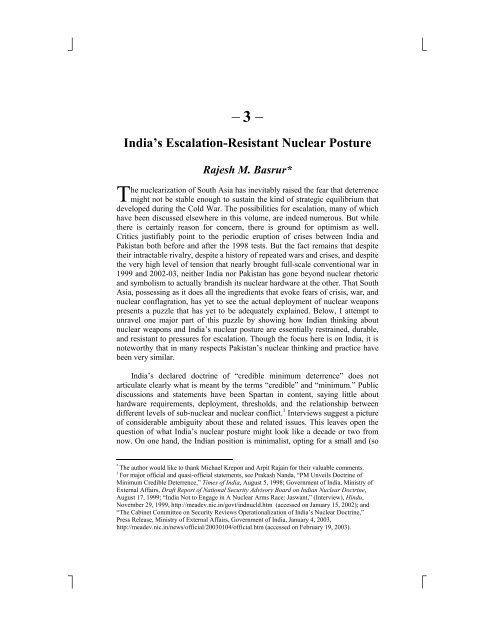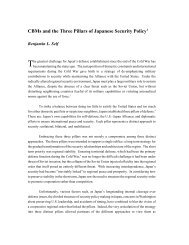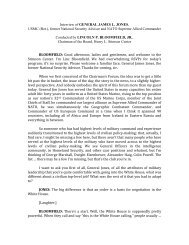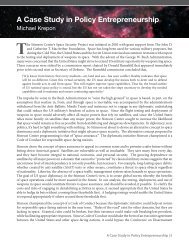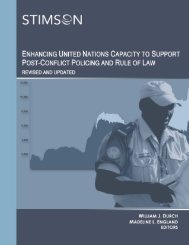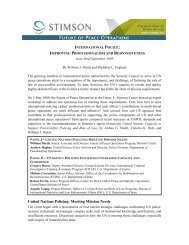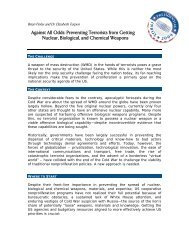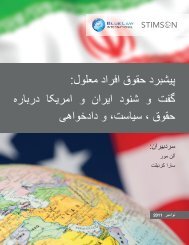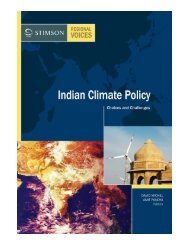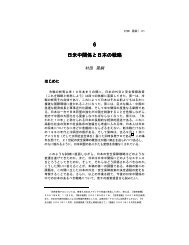India's Escalation-Resistant Nuclear Posture - The Stimson Center
India's Escalation-Resistant Nuclear Posture - The Stimson Center
India's Escalation-Resistant Nuclear Posture - The Stimson Center
You also want an ePaper? Increase the reach of your titles
YUMPU automatically turns print PDFs into web optimized ePapers that Google loves.
⎦<br />
⎣<br />
__<br />
3 __<br />
T<br />
India’s <strong>Escalation</strong>-<strong>Resistant</strong> <strong>Nuclear</strong> <strong>Posture</strong><br />
Rajesh M. Basrur*<br />
he nuclearization of South Asia has inevitably raised the fear that deterrence<br />
might not be stable enough to sustain the kind of strategic equilibrium that<br />
developed during the Cold War. <strong>The</strong> possibilities for escalation, many of which<br />
have been discussed elsewhere in this volume, are indeed numerous. But while<br />
there is certainly reason for concern, there is ground for optimism as well.<br />
Critics justifiably point to the periodic eruption of crises between India and<br />
Pakistan both before and after the 1998 tests. But the fact remains that despite<br />
their intractable rivalry, despite a history of repeated wars and crises, and despite<br />
the very high level of tension that nearly brought full-scale conventional war in<br />
1999 and 2002-03, neither India nor Pakistan has gone beyond nuclear rhetoric<br />
and symbolism to actually brandish its nuclear hardware at the other. That South<br />
Asia, possessing as it does all the ingredients that evoke fears of crisis, war, and<br />
nuclear conflagration, has yet to see the actual deployment of nuclear weapons<br />
presents a puzzle that has yet to be adequately explained. Below, I attempt to<br />
unravel one major part of this puzzle by showing how Indian thinking about<br />
nuclear weapons and India’s nuclear posture are essentially restrained, durable,<br />
and resistant to pressures for escalation. Though the focus here is on India, it is<br />
noteworthy that in many respects Pakistan’s nuclear thinking and practice have<br />
been very similar.<br />
India’s declared doctrine of “credible minimum deterrence” does not<br />
articulate clearly what is meant by the terms “credible” and “minimum.” Public<br />
discussions and statements have been Spartan in content, saying little about<br />
hardware requirements, deployment, thresholds, and the relationship between<br />
different levels of sub-nuclear and nuclear conflict. 1 Interviews suggest a picture<br />
of considerable ambiguity about these and related issues. This leaves open the<br />
question of what India’s nuclear posture might look like a decade or two from<br />
now. On one hand, the Indian position is minimalist, opting for a small and (so<br />
*<br />
<strong>The</strong> author would like to thank Michael Krepon and Arpit Rajain for their valuable comments.<br />
1<br />
For major official and quasi-official statements, see Prakash Nanda, “PM Unveils Doctrine of<br />
Minimum Credible Deterrence,” Times of India, August 5, 1998; Government of India, Ministry of<br />
External Affairs, Draft Report of National Security Advisory Board on Indian <strong>Nuclear</strong> Doctrine,<br />
August 17, 1999; “India Not to Engage in A <strong>Nuclear</strong> Arms Race: Jaswant,” (Interview), Hindu,<br />
November 29, 1999, http://meadev.nic.in/govt/indnucld.htm (accessed on January 15, 2002); and<br />
“<strong>The</strong> Cabinet Committee on Security Reviews Operationalization of India’s <strong>Nuclear</strong> Doctrine,”<br />
Press Release, Ministry of External Affairs, Government of India, January 4, 2003,<br />
http://meadev.nic.in/news/official/20030104/official.htm (accessed on February 19, 2003).<br />
⎤<br />
⎡
⎦<br />
⎣<br />
RAJESH M. BASRUR ⏐ 57<br />
far) non-deployed arsenal. On the other, as critics have pointed out, Indian<br />
nuclear doctrine is open-ended in its unhurried search for a range of capabilities,<br />
notably the development of a triad and the acquisition of missile defense<br />
capability. 2<br />
<strong>The</strong> essential features of Indian thinking about nuclear weapons may be<br />
outlined as follows: 1) nuclear weapons are not central to national security; 2) a<br />
nuclear arsenal does not require large, ready-to-use forces to deter an adversary;<br />
3) apparent imbalances in capabilities are tolerable; and 4) nuclear confidence<br />
building and arms control are desirable if strategic stability is to be obtained.<br />
Accordingly, in the nuclear era – which, if one excludes the 1974 test, dates<br />
back to the late 1980s, when India began to accumulate the first of its bombs in<br />
the basement – governments across the political spectrum in New Delhi have<br />
sought no more than a relatively small and non-deployed capability. Nondeployment<br />
greatly reduces the risk of crisis escalation, while tolerance of<br />
imbalances inhibits the long-term escalatory process of arms racing. <strong>The</strong> latter is<br />
complemented by a persistent interest in institutionalized restraint. It is notable<br />
that, unlike the United States and the Soviet Union, which came to the brink of<br />
nuclear war in 1962 before they began to build bridges of restraint, India and<br />
Pakistan signed their first nuclear-related confidence-building measure (CBM)<br />
not to attack each other’s nuclear facilities as early as 1988, when they had<br />
scarcely crossed the Rubicon of acquiring nuclear weapons.<br />
Might this change? As India’s nuclear edifice grows, the inconsistent<br />
elements in its doctrine could well be subject to pressures that cause New Delhi<br />
to drift away from nuclear minimalism to a more expansionary form of doctrine<br />
and practice. <strong>The</strong> pulls and pushes of newly perceived threats and organizational<br />
interests may be the drivers of change. Below, I assess the potentialities for<br />
change in India’s choices about nuclear hardware and posture, particularly with<br />
respect to the question of deployment. <strong>The</strong> appraisal is based on a series of<br />
interviews with individuals closely connected to policymaking conducted<br />
between mid-2003 and mid-2004. 3 I attempt to gauge whether policy makers<br />
today are satisfied with national deterrence capabilities, and whether they see a<br />
need for enhancing capabilities or changing India’s nuclear posture. Changes<br />
such as active deployment or competitive acquisitions are likely to invite<br />
strategic repercussions in India’s relationships with both Pakistan and China. I<br />
follow this up by assessing the prospects for change should environmental<br />
conditions be transformed.<br />
2<br />
See, e.g., P. R. Chari, “India’s <strong>Nuclear</strong> Doctrine: Confused Ambitions,” Nonproliferation Review 7,<br />
no. 3 (Fall-Winter 2000), pp. 123-135. Notably, official doctrinal statements do not even mention<br />
critical issues such as missile defense and the relationship between nuclear and sub-nuclear levels of<br />
conflict.<br />
3<br />
Because many of the conversations were conducted in confidence, I avoid citing names, with some<br />
exceptions. Of those that can be named, I owe thanks to Bharat Karnad, General V. P. Malik (retd),<br />
Rajesh Rajagopalan, Arpit Rajain, and Air Commodore Jasjit Singh (retd).<br />
⎤<br />
⎡
⎦<br />
⎣<br />
58 ⏐ INDIA’S ESCALATION-RESISTANT NUCLEAR POSTURE<br />
CURRENT PERCEPTIONS OF SUFFICIENCY OR INSUFFICIENCY<br />
<strong>The</strong> formulation of nuclear doctrine and strategy in India involves inputs<br />
from a number of sources. From the military side, inputs are routed through the<br />
Ministry of Defense (MoD), which pulls together thinking in the Perspective<br />
Planning Division and the Directorate of Net Assessment, Integrated Defense<br />
Staff. <strong>The</strong> military is also represented in the National Command Authority<br />
(NCA) and, less directly, in the National Security Advisory Board (NSAB) that<br />
has a staff function. <strong>The</strong> civilian side is more strongly represented. Apart from<br />
the MoD, the Disarmament Division of the Ministry of External Affairs (MEA),<br />
the National Security Council Secretariat (NSCN), and the NSAB play a role,<br />
with some inputs from the Cabinet Secretariat and the Prime Minister’s Office.<br />
<strong>The</strong> National Security Council (NSC) constitutes the upper level of decisionmaking,<br />
and final decisions are made by the Cabinet Committee on Security<br />
(CCS), chaired by the Prime Minister. A key person in this structure is the<br />
National Security Adviser (NSA). Under the National Democratic Alliance<br />
(NDA) coalition of Prime Minister Atal Behari Vajpayee, one individual played<br />
a key role. Brajesh Mishra, Principal Secretary to the government, not only<br />
headed the NSAB, but also sat in the NSC and the CCS and was a member of<br />
the inner circle of the Prime Minister’s advisors. Following the formation of the<br />
United Progressive Alliance (UPA) coalition government of Prime Minister<br />
Manmohan Singh in 2004, the national security advisory function has been<br />
divided. Former Foreign Secretary J. N. Dixit, the new NSA, is in charge of<br />
external security, while a former intelligence official, M. K. Narayanan, as<br />
Special Advisor to the Prime Minister, is responsible for advising on internal<br />
security. <strong>The</strong> latter has, at his own request, a purely advisory function.<br />
It is too early to say what these changes might mean for nuclear strategy<br />
except that the NSA’s narrowed jurisdiction should allow him to pay greater<br />
attention to nuclear issues than was the case with his predecessor. 4 <strong>The</strong> new<br />
Minister for External Affairs, Natwar Singh, is also a former Foreign Secretary<br />
and is likely to play a significant role in nuclear policy formulation. None of this<br />
implies any significant change in policy orientations. India’s minimalist strategic<br />
culture with respect to nuclear weapons, established by its first Prime Minister,<br />
Jawaharlal Nehru of the Congress party (which today leads the UPA coalition),<br />
is likely to remain largely unchanged under the Singh government. 5<br />
<strong>The</strong> armed forces have in practice a relatively limited role in doctrinal<br />
decisions or in determining posture. This is largely the result of a deeply rooted<br />
4<br />
I have argued elsewhere that Indian strategy during the Kargil crisis of 1999 and the India-Pakistan<br />
crisis of 2001-02 failed to comprehend the complex linkage between nuclear, conventional and subconventional<br />
conflict despite attention having been drawn to this by non-government experts. See<br />
Rajesh M. Basrur, “Coercive Diplomacy in A <strong>Nuclear</strong> Environment: <strong>The</strong> December 13 Crisis,” in<br />
Rafiq Dossani and Henry Rowen, eds., Prospects for Peace in South Asia (Stanford, CA: Stanford<br />
University Press) (forthcoming).<br />
5 Rajesh M. Basrur, “<strong>Nuclear</strong> Weapons and Indian Strategic Culture,” Journal of Peace Research<br />
38, no. 2 (March 2001), pp. 181-198.<br />
⎤<br />
⎡
⎦<br />
⎣<br />
RAJESH M. BASRUR ⏐ 59<br />
reluctance on the part of the ruling political elite to permit them to play a major<br />
part in determining security policy. Both these aspects of nuclear policy are<br />
civilian-driven, dominated by the NSA. However, it appears that the civilian<br />
bodies which have a nuts-and-bolts understanding of nuclear strategy, the NSAB<br />
and the NSCN, play a relatively limited role in formulating India’s nuclear<br />
stance today. 6 Though time will tell, there is some expectation that the UPA<br />
government will review and revamp the NSC and give it a more prominent role<br />
in policy making than before. 7 <strong>The</strong> nuclear-scientific community is often<br />
credited with a significant role in policy making. In practice, while it is true that<br />
nuclear scientists have generally been strong advocates of the bomb, there is no<br />
evidence of their being able to determine the agenda of even relatively weak<br />
political leaders. <strong>Nuclear</strong> decisions have always been political decisions. 8<br />
However, nuclear scientists associated with the development of missiles do push<br />
for expanding capabilities and will continue to do so. If the threat environment<br />
deteriorates, they are likely to find a sympathetic ear in the policymaking<br />
community.<br />
This brief overview provides the basis for an assessment of official thinking<br />
today, which is fundamentally minimalist and hence both stable and escalationresistant.<br />
Because the military does not have a significant say, operational<br />
pressures relating to issues such as deployment and force expansion are very<br />
limited. Have the requirements for minimum deterrence been met? In the main,<br />
official circles do not feel that they have. In particular, there is a widely felt need<br />
for three components of a minimal deterrence capability. <strong>The</strong> first is a capacity<br />
to deter China effectively, for which the 3,000 km-range Agni III intermediaterange<br />
missile, still under development, is seen as a necessity. China is not<br />
currently seen as a threat, but there are significant concerns about its intent in<br />
aiding Pakistan’s missile and nuclear programs. Some feel there is a need to<br />
target Beijing specifically, while others do not see this as a necessary<br />
requirement. After all, as the respected thinker K. Subrahmanyam, has noted,<br />
“Will the Chinese risk Kunming and Chengdu at present and even Shanghai and<br />
Guangzu later…for any conceivable political, military and strategic objective?” 9<br />
But the push for a China-specific deterrent is not characterized by a sense of<br />
urgency, which is not surprising considering the positive trend in Sino-Indian<br />
relations. <strong>The</strong> Agni III is slated for testing in 2004.<br />
So far, China has not taken India’s nuclearization seriously but that will<br />
almost certainly change. Once the Agni III is inducted into the Indian arsenal,<br />
there is likely to be a new dynamic in Sino-Indian relations. Chinese threat<br />
6<br />
<strong>The</strong> first NSAB, which put together the Draft <strong>Nuclear</strong> Doctrine of August 1999, was more<br />
influential, but its successors have not enjoyed a similar stature.<br />
7<br />
Siddharth Varadarajan, “Revamp of National Security Council on Cards,” Times of India, May 31,<br />
2004.<br />
8 Basrur, “<strong>Nuclear</strong> Weapons and Indian Strategic Culture,” pp. 189-190.<br />
9 K. Subrahmanyam, “Not A Numbers Game: Minimum Cost of N-Deterrence,” Times of India,<br />
December 7, 1998.<br />
⎤<br />
⎡
⎦<br />
⎣<br />
60 ⏐ INDIA’S ESCALATION-RESISTANT NUCLEAR POSTURE<br />
perceptions and targeting policies are bound to be reassessed and changes<br />
therein will inevitably call for a response from the Indian side. However, barring<br />
an unforeseen downturn in Sino-Indian relations, not much change may be<br />
expected. It is unlikely that technical dynamics will drive nuclear strategy<br />
toward major changes in either country. <strong>The</strong>ir relationship now rests on a<br />
political foundation that envisages setting difficult issues like their boundary<br />
dispute aside and focusing on areas of mutual benefit such as trade and<br />
investment. New Delhi does not express an interest in catching up with China,<br />
and India is unlikely to seek more than a minimal deterrence capacity against<br />
that country. <strong>The</strong> possibility of an escalation in tensions driven by nucleartechnological<br />
competition is remote. It should be noted that there is no serious<br />
perception in India of a need to develop intercontinental-missiles in the<br />
foreseeable future because no threat requiring this capability is anticipated.<br />
A second felt need is for a triad. It is not quite clear as to why this is<br />
considered necessary. <strong>The</strong> usual argument, based on thinking drawn from<br />
western assured destruction literature, is that submarine-based warheads are<br />
least vulnerable to a first strike. This is by no means deducible from a<br />
specifically minimum deterrence standpoint in which deterrence rests on the risk<br />
faced by the adversary rather than on one’s own invulnerability. 10 In practice,<br />
organizational interests and perceptions do seem to play an unacknowledged<br />
role in bolstering such arguments. <strong>The</strong> scientific community is certainly<br />
interested in the development of a sea-based platform, while the politics of interservice<br />
rivalry ensures that all three arms of the military get a piece of the cake.<br />
More generally, there is no clearly enunciated basis for the requirements of<br />
minimum deterrence as yet. While Indian strategic culture acts as a restraining<br />
factor, the lack of a well thought out and consistent doctrine allows considerable<br />
open-endedness in Indian nuclear thinking and practice. <strong>The</strong> question “how<br />
much is enough?” is not yet being asked in policymaking circles. In part, this<br />
reflects an awareness that to make any quantifiable commitment is to render<br />
oneself vulnerable to pressures from the international “nonproliferation lobby,”<br />
which is viewed with much contempt but also a degree of apprehension. In part,<br />
it is also the result of an unarticulated perception that nuclear weapons are not<br />
really a problem area because India has enough to deter Pakistan and because<br />
China is not a major worry for the foreseeable future. <strong>The</strong> result is that future<br />
uncertainties are the basis of a hedging strategy that is open-ended but not<br />
driven by a desire to get anywhere quickly. As things stand, this is not<br />
worrisome. But if India’s strategic relationships with China or Pakistan were to<br />
deteriorate, there would be scope for an expansionary, arms-racing process of<br />
the Cold War type, though within the constraints posed by strategic culture and<br />
10 <strong>The</strong> obvious criticism is how can an adversary be certain that one will not be able to retaliate with<br />
even one weapon from a single leg? Minimum deterrence, after all, is based on the contention that<br />
“one bomb on one city is unacceptable.” K. Subrahmanyam, “A Credible Deterrent: Logic of the<br />
<strong>Nuclear</strong> Doctrine,” Times of India, October 4, 1999.<br />
⎤<br />
⎡
⎦<br />
⎣<br />
RAJESH M. BASRUR ⏐ 61<br />
cost. <strong>The</strong>re is a need – as yet unrecognized by officialdom – for a clearer<br />
conception of minimum deterrence doctrine to prevent this from happening.<br />
<strong>The</strong> third area where the necessity for improved capability is sensed is<br />
command and control. <strong>The</strong> need for integrating command and control capability<br />
more fully is a subject of some concern, and organizational matters are still<br />
being sorted out. While precise information on this is not available, it appears<br />
that technical requirements relating to more effective command and control,<br />
such as permissive action links (PALs), are still to be obtained. Western thinking<br />
is dominated by the fear that the attainment of such capability is likely to result<br />
in active deployment, but that is very unlikely as there is a strong awareness of<br />
the associated risks. Missile defense capability is also considered necessary to<br />
protect major assets and has been sought persistently for some years. More<br />
about this is discussed below.<br />
<strong>The</strong> overall picture is that barring unexpected changes in the nature of<br />
external threats, there is no likelihood of internally driven shifts in doctrine or<br />
practice. Even at the height of tension with Pakistan, during both the 1999<br />
Kargil conflict and the 2001-02 compound crisis, nuclear weapons never<br />
seriously entered the picture other than verbally. Like Sherlock Holmes’s dog<br />
that did not bark (in this case twice), this absence was significant. It reflected<br />
well-entrenched Indian (and Pakistani) inhibitions about nuclear weapons based<br />
on an acute awareness of the risks accompanying them. <strong>The</strong>re seems to be a<br />
sense that there is already second-strike stability vis-à-vis Pakistan, and that this<br />
will be achieved relatively soon with respect to China. Above all, there is no<br />
sign of significant civilian-military differences over nuclear matters. As<br />
mentioned earlier, civilian control remains tight. Beyond that, while military<br />
officers do seek greater inputs into policy, their perspective on major issues like<br />
deployment and hardware is not very different from that of the civilian<br />
leadership. Notably, there is no pressure from the armed forces for tactical or<br />
“battlefield” weapons and “warfighting” capability, nor for testing to ensure<br />
greater reliability of weapons systems. <strong>The</strong> possibility of small nuclear weapons<br />
for use against military targets has been raised within the armed forces, but has<br />
found no support from senior military officers, let alone the political leadership.<br />
What does this imply for escalation control? <strong>The</strong>re is a certain element of<br />
instability in the existence of a hedging strategy that could drive rapid armament<br />
in a more insecure environment. Similarly, the persistent interest in obtaining a<br />
fully developed triad because it would allegedly make the Indian deterrent force<br />
less vulnerable is not only of dubious merit, but also expansionary in its<br />
implications. Arguments about vulnerability (recall the “bomber gap” and the<br />
“missile gap”) were the prime propellants of the arms race during the Cold War.<br />
<strong>The</strong> absence of a fully thought out doctrine of minimum deterrence leaves some<br />
space – again more likely in a deteriorating environment – for expansionary<br />
pressures on grounds such as “vulnerability” or “credibility.” For a truly<br />
minimum deterrence posture, such gaps should not matter, nor should issues of<br />
⎤<br />
⎡
⎦<br />
⎣<br />
62 ⏐ INDIA’S ESCALATION-RESISTANT NUCLEAR POSTURE<br />
vulnerability or credibility, since, from this perspective, deterrence rests on the<br />
enemy’s unwillingness to accept even a small risk of large-scale damage. This is<br />
a lacuna that needs to be addressed since it allows escalation under changed<br />
external conditions. On the other hand, India’s tolerance of a high level of<br />
tension (and even the actual outbreak of armed conflict in the case of Kargil)<br />
without recourse to direct nuclear escalation encourages a more sanguine<br />
perspective, as does the refusal to consider nuclear warfighting seriously.<br />
POTENTIAL SOURCES OF CHANGE<br />
While change seems unlikely to result primarily from domestic drivers of<br />
policy, there is still the possibility of shifts in doctrine or posture arising from<br />
alterations in the external environment. <strong>The</strong>se can be divided into two<br />
categories: those resulting from general threat perceptions relating to existing or<br />
potential adversaries, and those consequent upon specific and/or more<br />
immediate threats to national security. General threats or concerns are likely to<br />
affect issues such as the size and sophistication of the nuclear arsenal. Threats<br />
more pressing in nature are likely to affect the vital question of deployment.<br />
Broad-spectrum Concerns<br />
<strong>The</strong> major concerns in this category, of course, are India’s relationships<br />
with China and Pakistan. Though these are at present very different in nature,<br />
there are some common elements. For India, both relationships encompass longstanding<br />
territorial disputes; a history of subconventional interventions, war, and<br />
periodic crises; and nuclear threat perceptions. Besides, the existence of a<br />
strategic nexus between China and Pakistan, particularly the repeated reports of<br />
Chinese nuclear and missile assistance to Pakistan, adds to Indian threat<br />
perceptions in both cases. 11 Yet the general tenor and trend of the two are very<br />
different. <strong>The</strong> Sino-Indian relationship can be regarded as a form of oligopolistic<br />
competition, in which rivals compete in a stable environment, cooperating in<br />
numerous ways to ensure a fundamentally stable relationship. In contrast, the<br />
Indo-Pakistan relationship is a model of spiraling hostility in which the use of<br />
force or threat of force is continually present. 12 China does, however, remain a<br />
significant long-term concern for Indian strategy.<br />
How do Indian policy makers view China today? <strong>The</strong>re is little doubt that<br />
Sino-Indian relations have come a long way since the 1962 war and the<br />
prolonged tensions that followed in its wake. Despite the chill caused by India’s<br />
citing of the Chinese threat to justify its 1998 nuclear tests, trade grew from $1.1<br />
11 T. V. Paul, “Chinese-Pakistani Missile Ties and the Balance of Power,” Nonproliferation Review<br />
10, no. 2 (Summer 2003), pp. 1-9.<br />
12<br />
For a discussion of the contrast, see Rajesh M. Basrur, “<strong>Nuclear</strong> India at the Crossroads,” Arms<br />
Control Today 33, no. 7 (September 2003), pp. 7-11.<br />
⎤<br />
⎡
⎦<br />
⎣<br />
RAJESH M. BASRUR ⏐ 63<br />
billion in 1995 to nearly $3.5 billion in 2001. 13 Border confrontations in 1987<br />
and 2003 were resolved by political negotiations. <strong>The</strong> shrill rhetoric of the past<br />
has given way to an unprecedented degree of bonhomie and expressions of<br />
goodwill. Current thinking in India is that the main issues of the border dispute<br />
and China’s defense relationship with Pakistan do not constitute a near-term<br />
threat, and that, notwithstanding China’s much larger nuclear inventory, a stable<br />
strategic relationship is likely to be sustained. Once Indian deterrent capability is<br />
augmented by the induction of the Agni III missile, a major step toward<br />
deterrence stability will have been achieved.<br />
<strong>The</strong> China-Pakistan connection, however, remains the main obstacle to a<br />
truly warm relationship. <strong>The</strong>re is still considerable concern that Chinese strategy<br />
harbors a desire to contain India through Pakistan and through a more active<br />
military presence in Myanmar and the northern Indian Ocean. An underlying<br />
cause for caution is the perception that China is still to demonstrate its<br />
commitment to non-violent resolution of disputes, and that this in turn reflects a<br />
proclivity for the use of force, which may be constrained only temporarily by the<br />
exigencies of current economic policies. In short, while China is not viewed as a<br />
problem today, the possibility that it will become one remains open. A renewed<br />
challenge might be military-strategic or geopolitical. In the former case, what if<br />
China deploys multiple-warhead missiles? Alternatively, how would India react<br />
if China began a rapid enhancement of capabilities in response to US<br />
deployment of missile defense or the weaponization of space? Leaving aside the<br />
question of these developments actually occurring, it is doubtful that they would<br />
in themselves evoke alarm in India. So long as Sino-Indian relations remain on<br />
the present path of growing closeness, there will be relatively little concern.<br />
True, defense threat planning will likely respond to the enhancement of Chinese<br />
capabilities. But Indian thinking is less inclined to hard military realpolitik and<br />
more to the view that politics is the primary driver of strategy. This approach,<br />
which might be called soft realism, understands that policies do not change<br />
overnight, and that in any case, India’s ability to deter China remains.<br />
If there is political cause for worry, for instance if Sino-Indian relations<br />
were to deteriorate, the Indian response would be less relaxed. An armed<br />
Chinese engagement with Taiwan, violent repression of a Tibetan uprising, or an<br />
aggressive shift in China’s external stance under a new leadership would cause<br />
deep unease. <strong>The</strong>n, in the event of renewed military-strategic tensions, there<br />
would be pressure to respond by enhancing nuclear capability qualitatively or<br />
quantitatively, and perhaps by a shift to active deployment. Indian thinking<br />
about how much nuclear hardware is adequate rests upon a sufficiently unclear<br />
basis to permit the possibility that an enhanced Chinese threat will cause a major<br />
reassessment. A more careful understanding of the fundamentals of minimum<br />
deterrence should help forestall the kind of drift into nuclear expansion that this<br />
13 “Sino-Indian Trade Statistics, Table 1: Sino-Indian Trade(1995-2001),” Ministry of External<br />
Affairs, available at http://www.meadev.nic.in/foreign/ind-china.htm (accessed May 28, 2003).<br />
⎤<br />
⎡
⎦<br />
⎣<br />
64 ⏐ INDIA’S ESCALATION-RESISTANT NUCLEAR POSTURE<br />
might engender. But, to reiterate, there is no present concern in this regard, nor<br />
does there seem to be reason for it.<br />
<strong>The</strong> Pakistani threat is more immediate. Pakistan is viewed with<br />
considerable distrust after the Kargil conflict, which Prime Minister Atal Behari<br />
Vajpayee once described as a stab in the back. 14 Besides, Pakistani support for<br />
terrorists operating in Kashmir over the years has been the source of constant<br />
tension between the two countries. After 1998, the escalation of terrorist activity<br />
– and particularly the attack on India’s parliament in December 2001 – has led<br />
to a sharp rise in hostility toward Pakistan. <strong>The</strong> ten-month long confrontation of<br />
large-scale forces that followed brought mutual threats of nuclear strikes and<br />
counter-strikes. Even though neither side went beyond spoken threats and titfor-tat<br />
missile testing, the nuclear factor remained in the forefront. <strong>The</strong>re was a<br />
perception among Indian leaders that Pakistan was able to take full advantage of<br />
the “stability-instability paradox” partly because India’s nuclear capability was<br />
stymied by Pakistan’s. 15<br />
In this context, my conversations frequently brought forth the response that<br />
minimum deterrence is not a fixed position, and that its requirement depends on<br />
the degree of threat. Several interlocutors argued that a raised threat level would<br />
necessitate an appropriate response in terms of nuclear posture. Despite the<br />
understanding that minimum deterrence does not require that forces be balanced,<br />
a visibly enhanced threat, it was held, would require a visible response. In the<br />
case of Pakistan in particular, such a response would be a political necessity,<br />
partly because Pakistani leaders would be prone to act upon a perceived<br />
advantage (as in their exploitation of the stability-instability paradox with regard<br />
to Kargil), and partly because no government could risk the domestic political<br />
repercussions of a failure to act. <strong>The</strong> same argument was not usually made with<br />
regard to China, largely because the Chinese threat is not viewed as imminent,<br />
but the logic clearly applies here as well. An enhanced Chinese threat would<br />
likely invite an expansionary response.<br />
Such views reflect an unclear conception of the fundamentals of minimum<br />
deterrence doctrine. While any fixed position on the question “how much is<br />
enough?” is bound to be arbitrary, minimum deterrence as seen in the context of<br />
India’s nuclear history and strategic culture must surely approach this question<br />
from the standpoint of the costs or risks of possessing nuclear weapons and the<br />
deterrent benefits derived from them. From the historical evidence, no matter<br />
what specific doctrine states officially adhere to, their actual strategic behavior<br />
corresponds to the tenets of minimum deterrence. That is, no matter what<br />
doctrine states claim to adhere to, they are in practice easily deterred from using<br />
14 Harjinder Sidhu, “Ansari Arrest Proves Pak Hand: PM,” Hindustan Times, February 11, 2002.<br />
15<br />
On the “stability-instability paradox,” see Michael Krepon and Chris Gagné, eds., <strong>The</strong> Stability-<br />
Instability Paradox: <strong>Nuclear</strong> Weapons and Brinksmanship in South Asia (Washington DC: <strong>The</strong><br />
Henry L. <strong>Stimson</strong> <strong>Center</strong>, June 2001).<br />
⎤<br />
⎡
⎦<br />
⎣<br />
RAJESH M. BASRUR ⏐ 65<br />
nuclear weapons. Numerical balances or those relating to technical<br />
sophistication mean little when a state contemplates the prospect of nuclear<br />
damage, even on a relatively “small” scale (say, one bomb on one city). This<br />
reality applied to American policy makers in the Cuban missile crisis, and to<br />
Soviet policy makers during the Sino-Soviet border clashes of 1969.<br />
Arguably, an expansionary Indian response to a Chinese or Pakistani<br />
upgrading of capabilities, including that undertaken in the garb of “strategic<br />
modernization,” would go against the fundamentals of minimum deterrence,<br />
which holds that once deterrence has been established, the acquisition of more<br />
or “better” weapons is of no utility. For the enemy, the “one bomb on one city”<br />
problem would not change. Acquisition of more or bigger or “better” weapons<br />
does not add to deterrence. It has only a symbolic meaning. On the other hand,<br />
the attitude which regards such acquisition as necessary is problematic. Such an<br />
approach leaves the door open to indefinite growth and is hostage to the<br />
preferences of others and to the exigencies of domestic politics (including<br />
demands for “strategic modernization”).<br />
One area which appears to have received inadequate attention is the threat<br />
posed by nuclear/radiological terrorism. Given the history of tension between<br />
India and Pakistan over the latter’s support for radical Islamic groups active in<br />
India, there are important reasons for concern. First, neither country seems able<br />
to control the activity of such groups. <strong>The</strong> Jaish-e-Muhammad (JeM), which has<br />
been fighting in the Indian-held portion of Kashmir, has also been connected<br />
with attempts to assassinate President Pervez Musharraf. 16 Second, the JeM and<br />
other groups are linked to Al Qaeda, which has a known interest in obtaining<br />
nuclear capability. 17 And third, Pakistan has a history of nuclear leakages<br />
emanating from its nuclear-scientific establishment. 18 <strong>The</strong> terrorist attack on<br />
India’s parliament in December 2001 led to a major military confrontation<br />
between the two countries. If a nuclear or even a radiological attack (by means<br />
of a “dirty bomb”) were to occur, the effect would be far worse. 19 This time, the<br />
Indian government would find it very difficult to stop short of military action,<br />
with potentially horrendous consequences.<br />
Though the Sino-Pakistan connection is often cited as a threat, there does<br />
not appear to be much disquiet about a two-front nuclear problem. This is in<br />
16<br />
Kamran Khan and John Lancaster, “Pearl Accomplice Tied to Attempts on Musharraf,”<br />
Washington Post, May 28, 2004.<br />
17<br />
Rohan Gunaratna, Inside Al Qaeda: Global Network of Terror (New York: Columbia University<br />
Press, 2002), pp. 208-209;<br />
18<br />
Leonard Weiss, “Pakistan: It’s Deja Vu All over Again,” Bulletin of the Atomic Scientists 60, no. 3<br />
(May/June 2004), pp. 52-59.<br />
19<br />
For a detailed analysis of the potential consequences of nuclear terrorism in the subcontinent, see<br />
Kishore Kuchibhotla and Matthew McKinzie, “<strong>Nuclear</strong> Terrorism and <strong>Nuclear</strong> Accidents in South<br />
Asia” in Michael Krepon and Ziad Haider, eds., Reducing <strong>Nuclear</strong> Dangers in South Asia<br />
(Washington DC: <strong>The</strong> Henry L. <strong>Stimson</strong> <strong>Center</strong>, January 2004).<br />
⎤<br />
⎡
⎦<br />
⎣<br />
66 ⏐ INDIA’S ESCALATION-RESISTANT NUCLEAR POSTURE<br />
accord with the minimum deterrence principle that balances do not matter very<br />
much. Nor is there much concern that imbalances in conventional forces can<br />
drive nuclear acquisitions. This, too, is reasonable. Contrary to the oft-expressed<br />
view that conventional imbalance increases reliance on nuclear weapons, 20 the<br />
role of conventional weapons actually decreases in a nuclear environment as<br />
full-scale conventional conflict becomes non-viable. If nuclear weapons deter<br />
“regular” war, why should conventional balances matter?<br />
On the global strategic canvas, there is no serious apprehension in India that<br />
a nuclear threat is present or approaching. Though they are uncomfortable with<br />
the concept of “proliferation” because it is cast in a west-centric mould, Indian<br />
policy makers are just as concerned about the spread of nuclear capability<br />
through covert means, particularly as it has been happening from Pakistan.<br />
However, they are not particularly anxious about North Korea or, closer to<br />
home, Iran. <strong>The</strong> hedging approach takes unknowable developments into<br />
account. US interest in earth penetrating or bunker-busting warheads, Russian<br />
development of new long-range missiles, and the prospect of an indefinite era of<br />
nuclear weapons all confirm the validity of hedging. <strong>The</strong>re is no sentiment in<br />
favor of capping capabilities. At the same time, there is virtually none in favor<br />
of galloping growth. Given the anarchic, self-help character of the international<br />
system and the lack of a universal regime regulating nuclear weapons, the<br />
decision to maintain a small deterrent force and to conduct limited research and<br />
development on nuclear capabilities is reasonable and pragmatic. Absent a<br />
severe threat to India’s deterrent capability, the expansion of weapon systems<br />
much beyond those available at present would be needlessly expensive,<br />
superfluous and strategically counterproductive.<br />
What if the incipient Comprehensive Test Ban Treaty (CTBT)<br />
disintegrates? If the United States and others resume testing, pressure to test<br />
would certainly come from some members of the nuclear-scientific community.<br />
An alliance may develop between them and likeminded individuals from the<br />
political right, hardliners in the strategic elite, and possibly the armed services.<br />
This alone is unlikely to bring policy change. Policy makers are aware that a<br />
fresh round of tests will detract from regional strategic stability. But in<br />
combination with the perception of a rising threat from one of the sources<br />
discussed above, it would almost certainly create great pressure for testing, force<br />
expansion, and the refinement of capabilities. In the absence of testing triggered<br />
by another country, a universal test ban that is compatible with Indian interests<br />
will retain its appeal.<br />
20 For a contrary view, see Rodney Jones’ companion essay in this book.<br />
⎤<br />
⎡
⎦<br />
⎣<br />
RAJESH M. BASRUR ⏐ 67<br />
Missile defense is an area in which India seeks to enhance its capability. 21<br />
Government officials are aware of the possibility that the acquisition of missile<br />
defenses may trigger an expansionary response in Pakistan. But their interest<br />
remains strong, primarily because of uncertainty with regard to Pakistan,<br />
including the possibility of a “rogue launch.” <strong>The</strong>re is less concern about the<br />
possible cascading effect of the planned US missile defense deployment via<br />
China. While there may be good arguments for this relaxed view of missile<br />
defense, those are not usually discernible in official thinking. 22 Official<br />
understanding of the full implications of missile defense does not seem to be<br />
very lucid. <strong>The</strong>re is no clarity as to how much can be defended and to what<br />
effect in the context of deterrence stability. One senior bureaucrat closely<br />
associated with nuclear policy rather simplistically described missile defense as<br />
“an extension of air defense.”<br />
Interestingly, missile defense draws considerable support from the scientific<br />
community, and not much from the armed forces. One factor which has not been<br />
adequately appreciated is that if India obtains significant missile defense<br />
capability, Pakistan may well respond by enhancing its penetration capabilities,<br />
which in turn would invite a counter-response from India. <strong>The</strong>re is scope here<br />
for arms racing, or at least an accelerated crawl. Strictly speaking, since no one<br />
is claiming that missile defense will ever be anywhere close to perfect, and since<br />
minimum deterrence rests on the principle that even one bomb getting through is<br />
too many, this should not matter. Besides, both countries offer each other so<br />
many targets along their border that missile defenses will make little difference<br />
to deterrence except to those who hold the indefensible view that some targets<br />
are expendable or, even more untenably, that only some targets must be<br />
defended at all costs. But there is something about the Indo-Pakistan relationship<br />
that goes beyond dry logic. Even if the risk of a consequent change in actual<br />
posture is not great, the prospect of arms racing hovers in the wings. 23 This is<br />
clearly an area that needs close attention in forthcoming negotiations. At some<br />
point in the future, differences over missile defense might become a sticking<br />
point in Indo-Pakistan negotiations for strategic stability. Pakistan will want to<br />
press for Indian restraint on this issue. But the problem is not likely to be<br />
serious. <strong>The</strong> relatively mild reactions of Russia and China to American plans for<br />
21<br />
Though India’s interest in missile defense is often associated with the BJP-led government that<br />
was voted out of office in 2004, the Indian search for missile defense capability is a long-standing<br />
one which cuts across party lines. <strong>The</strong> present Congress-led government has affirmed continuity in<br />
this respect. See Amit Baruah, “UPA Continuing NDA Policy on Missile Defence,” Hindu, August<br />
20, 2004.<br />
22<br />
For a sanguine view of missile defense, including its potential impact on Indian security, see<br />
Rajesh M. Basrur, “Missile Defense: An Indian Perspective,” in Chris Gagné and Michael Krepon,<br />
eds., <strong>The</strong> Impact of Missile Defenses on Southern Asia (Washington, DC: <strong>The</strong> Henry L. <strong>Stimson</strong><br />
<strong>Center</strong>, 2002). <strong>The</strong> remaining papers in the volume are less optimistic.<br />
23<br />
Something of the sort is already happening with respect to Pakistan, which is developing missiles<br />
with longer ranges – such as the 3,500-km-range Ghauri III – apparently in the belief that more is<br />
better.<br />
⎤<br />
⎡
⎦<br />
⎣<br />
68 ⏐ INDIA’S ESCALATION-RESISTANT NUCLEAR POSTURE<br />
missile defense deployment, which reflect their perception that substantive<br />
political relations are paramount, are indicative in this respect.<br />
Looking to the Future<br />
<strong>The</strong>re is a strong commitment in India to the present posture of not<br />
deploying nuclear weapons and keeping warheads in a disassembled condition.<br />
Since this is a key feature of nuclear posture, and the basis of a high degree of<br />
stability, I sought to gauge the conditions under which the policy might change.<br />
This could occur in different ways. First, the government might decide to<br />
assemble warheads and hand them over to the armed forces for mating with<br />
delivery vehicles during peacetime. Second, the same may be done only if there<br />
is a crisis and the specter of war is in the air. Non-deployment in peacetime has<br />
the advantage of stabilizing strategic relationships that are under sustained<br />
tension, as is the case between India and Pakistan. It constitutes the nuclear<br />
version of non-offensive defense. 24 While most policy makers are supportive of<br />
non-deployment for this reason, some do feel that a modicum of “transparency”<br />
or visibility would send stronger signals of a soundly organized deterrent. This<br />
would include, for instance, a greater synergy of the political, scientific, and<br />
military branches of government through regular exercises. But the need for<br />
credibility is an inadequate reason for deployment during peaceful times. An<br />
adversary’s knowledge that India possesses nuclear weapons, and that these can<br />
be assembled in short order, suffices to deter it.<br />
<strong>The</strong> stability-from-experience argument is a better one. Should a crisis<br />
occur, the experience derived from regular exercises with deployed weapons<br />
(including practice in the mating of warheads within a given time frame) would<br />
be invaluable in ensuring a smooth transition to deployment. In the absence of<br />
such preparation, the transition to deployment could be problematic, subject to<br />
errors and accidents. A stronger objection to non-deployed forces is that a<br />
decision to deploy during a crisis could be wrongly interpreted as preparation to<br />
go to war. However, the tradeoff between the advantages and disadvantages of<br />
deployment is, in my judgment, correctly deemed an acceptable one: the safety<br />
and stability aspects of non-deployment in peacetime outweigh the risks.<br />
Besides, there is a keen sense among the civilian leadership that handing over<br />
nuclear weapons to the armed forces other than in exceptional circumstances is<br />
undesirable. For its part, the military has not displayed a strong inclination to<br />
obtain direct jurisdiction over the weapons.<br />
How would India react if Pakistan were to deploy unilaterally, perhaps<br />
covertly? <strong>The</strong> almost automatic response, if such deployments are detected,<br />
would be a matching Indian deployment, to a large extent driven by a sense that<br />
Pakistani leaders, with their obsessive revanchism, are not entirely “rational”<br />
24<br />
On non-offensive defense, see Bjørn Møller, Common Security and Nonoffensive Defense: A<br />
Neorealist Perspective (Boulder, CO: Lynne Rienner, 1992).<br />
⎤<br />
⎡
⎦<br />
⎣<br />
RAJESH M. BASRUR ⏐ 69<br />
(which I understand to mean “sensible”). India would have to respond in an<br />
observable way to convey resolve to the adversary, and to reduce the time for a<br />
response.<br />
What if Pakistan has adopted, or were to adopt, a decapitation strategy?<br />
This would be hard for India to confirm, and would probably not be taken<br />
seriously. Indeed, one Indian official’s response to this question was that<br />
Pakistanis are not that irrational! <strong>The</strong> possibility is generally discounted,<br />
reflecting the view that such an argument is typical of Cold War logic and not<br />
rooted in South Asian reality. <strong>The</strong>re is uniform agreement that deployment will<br />
occur only in the event of a severe crisis. Given the fact that neither the 1999<br />
Kargil conflict nor the 2001-2002 compound crisis brought a nuclear<br />
confrontation, a decapitation strike is generally viewed as an unlikely event. One<br />
interlocutor pointed out that even in a grave crisis, the government would be<br />
inclined to explore pre-deployment options such as strong verbal signaling<br />
warning of impending deployment. <strong>The</strong> Indian reasoning seems basically sound.<br />
Pakistan has shown an inclination to use unconventional strategies against India<br />
under the nuclear umbrella, but not nuclear ones.<br />
It is sometime argued that Pakistan’s rejection of a no first use (NFU)<br />
posture bespeaks a readiness to cross the nuclear threshold. But that does not<br />
explain its nuclear restraint, mirroring India’s, in 1999 and 2001-02. Analysts<br />
have paid little attention to the remarkable fact that, notwithstanding the<br />
differences in Indian and Pakistani leaderships (the one civilian, the other<br />
military) and nuclear doctrines (on NFU, and possibly on tactical weapons,<br />
which Indian policy makers largely reject), there has been much similarity in<br />
their strategic behavior in the nuclear era. 25 Like India, Pakistan has exercised<br />
great restraint in not deploying nuclear weapons, and in stopping well short of<br />
using conventional force fully, even at the height of confrontation. <strong>The</strong>re is no<br />
incentive for Pakistan to seek nuclear advantage vis-à-vis India through early<br />
deployment since that would inevitably be neutralized by a matching Indian<br />
response. A decapitation strategy is unfeasible because it would prompt an early<br />
annihilating response. <strong>The</strong> fact that a tacit agreement on non-deployment exists<br />
reflects a common appreciation in the two countries that the risks associated<br />
with nuclear possession are not to be taken lightly.<br />
<strong>The</strong> relationship between nuclear weapon deployment and terrorism has not<br />
been sufficiently appreciated. In a neighborhood rife with terrorist activity,<br />
deployment – let alone a launch-on-warning or a hair-trigger posture – would<br />
offer new and tempting targets to terrorists. A terrorist attack on deployed Indian<br />
nuclear forces would almost certainly have a profoundly destabilizing impact on<br />
Indo-Pakistan strategic relations. This could occur in at least two ways. First, it<br />
could lead to the same sort of reaction that brought the military confrontation of<br />
25 For the view that future acquisition of tactical weapons by both cannot be ruled out, see the essay<br />
in this volume by Michael Krepon, Ziad Haider, and Charles Thornton.<br />
⎤<br />
⎡
⎦<br />
⎣<br />
70 ⏐ INDIA’S ESCALATION-RESISTANT NUCLEAR POSTURE<br />
2001-02. Second, and worse, it could trigger a nuclear response under the<br />
misapprehension that a Pakistani attack is under way. <strong>The</strong> same argument<br />
applies to Pakistan.<br />
On balance, it seems highly unlikely that Indian forces will change from the<br />
present posture of peacetime storage to active deployment, i.e., to a status where<br />
the time taken to launch is a matter of a few minutes. <strong>The</strong> fillip to such a shift, if<br />
it comes at all, is expected to come from Pakistan. Given the reality that<br />
Pakistan’s nuclear policy in most respects has been responsive to India’s,<br />
stability on this score is to be expected. However, if there is a well-founded<br />
perception in India that Pakistan has “cheated,” say by covertly mating warheads<br />
with launch vehicles and deploying them, India is likely to follow suit (and vice<br />
versa). Such possibilities, which highlight the strategic interdependence of the<br />
two states, underscore the need for nuclear confidence building between the two<br />
countries. It is worth pointing out that although Indians do not often think in<br />
similar terms about China today, much of the above would apply to that country<br />
as well in the event that the Sino-Indian relationship deteriorates.<br />
THE PROSPECTS FOR STABILIZATION<br />
Despite its history of war and tensions with Pakistan and China – or perhaps<br />
because of this – India has had a consistent interest in nuclear stability. Indians,<br />
long accustomed to think and speak of universal disarmament, do not often use<br />
the term “arms control,” even today. In any case, interest in arms control, which<br />
has much to do with specific technical and numerical limitations on weapons<br />
systems, is limited. <strong>The</strong>re are two main reasons for this. First, regardless of the<br />
widely expressed fear that South Asia has recurrently teetered on the edge of the<br />
nuclear precipice, the actual prospect of nuclear conflict has remained relatively<br />
distant. <strong>The</strong>re is no real evidence that nuclear weapon use has ever been<br />
contemplated during any crisis in the region. Hence the incentives for arms<br />
control have been limited. Second, the potential for specific arms control<br />
restrictions is complicated by the fact that India has two nuclear adversaries, one<br />
of which, China, refuses to acknowledge India’s de facto nuclear power status<br />
and negotiate with it. Hence, nuclear stabilization efforts have been confined to<br />
confidence-building measures (CBMs) with Pakistan. <strong>The</strong>se are in large<br />
measure aimed at mutual reassurance and the cultivation of political ground for<br />
stability. As noted earlier, the agreement not to attack each other’s nuclear<br />
facilities came a decade before the 1998 tests. Less than a year after the tests,<br />
India and Pakistan in February 1999 signed the Lahore Memorandum of<br />
Understanding (MoU) on nuclear restraint measures. 26 After the post-Kargil<br />
downturn, India and Pakistan resumed negotiations in June 2004. <strong>The</strong> initial<br />
results were incremental: improved lines of communication, movement toward a<br />
test notification agreement, and reaffirmation of individual moratoria on testing.<br />
26 For a brief discussion, see Raja Menon, “<strong>Nuclear</strong> Doctrine in South Asia,” in P. R. Chari, Sonika<br />
Gupta, and Arpit Rajain, eds., <strong>Nuclear</strong> Stability in Southern Asia (New Delhi: Manohar, 2003), pp.<br />
106-7.<br />
⎤<br />
⎡
⎦<br />
⎣<br />
RAJESH M. BASRUR ⏐ 71<br />
Though many have expressed disappointment at the limited progress at the time<br />
of writing (mid-September 2004), the fact that negotiations have taken place at<br />
all is encouraging.<br />
If Indo-Pakistan relations improve, progress can be expected along the lines<br />
identified by the Lahore MoU. 27 Given the less than cordial strategic history of<br />
the two countries, sustained progress along these lines is far from certain. Much<br />
will depend on whether the political relationship between India and Pakistan<br />
proceeds on a more even tenor. <strong>The</strong>re are three main possible trends. In the<br />
unlikely event that the Kashmir issue is satisfactorily resolved, there would be<br />
rapid strides in escalation control, confidence building, and nuclear riskreduction<br />
measures (NRRMs). Extensive arms control is still unlikely to be<br />
acceptable to India unless China is ready to negotiate as well, which is difficult<br />
to foresee today. A second possibility is the replication of the Sino-Indian model<br />
in Indo-Pakistan relations. Such a situation would leave the border issue on the<br />
backburner, bring stabilizing measures (CBMs, NRRMs) to front stage, and<br />
revive the prospect of economic cooperation. A third possibility is a return to the<br />
seesaw of crisis and negotiations, with the threat of war and nuclear<br />
conflagration ever present in the background. Of the three, the first seems least<br />
likely because political elites in both countries are not well placed to<br />
compromise on Kashmir, even were they inclined to do so. <strong>The</strong> third is possible,<br />
but seems nevertheless unlikely: the elites in both countries have failed to obtain<br />
success in pressurizing each other in 1999 and 2001-02 through strategies of<br />
compellence and appear to have acknowledged this by dropping their nonnegotiable<br />
preconditions to talks. 28<br />
<strong>The</strong> second possibility remains the most likely one. <strong>The</strong> intensity of the<br />
Kashmir problem and the baggage of history will make the shift from a spiraling<br />
hostility model to an oligopolistic competition model difficult, slow, and<br />
uneven. What would be the nature of the nuclear-strategic relationship under<br />
such conditions? Overall, there would be a preference for escalation-resistant<br />
competition and continued non-deployment; low-key development of delivery<br />
capability by way of an “arms crawl;” and improvement of command and<br />
control systems to improve stability. As noted above, the three main areas where<br />
the Indian strategic community feels the need for improved capability are<br />
missile capability against China; the acquisition of a triad; and enhancement of<br />
command and control systems. Of these, only the second has the potential to<br />
provoke Pakistan, but this too is a capability that is unlikely to be developed for<br />
27 <strong>The</strong> road map laid down by the Lahore MoU focuses on bilateral consultations on security<br />
concepts and nuclear doctrines; advance notification of ballistic missile tests; national measures to<br />
prevent unauthorized use, and notification in case such use occurs; an agreement on avoidance of<br />
further testing; measures to prevent incidents at sea; a mechanism to review the implementation of<br />
CBMs; enhanced communication channels; and consultations on disarmament issues.<br />
28<br />
Prior to the fresh round of negotiations in 2004, India insisted that cross-border terrorism must<br />
cease first, while Pakistan maintained that the resolution of the Kashmir problem came first. On the<br />
use of compellence strategies in the subcontinent, see Basrur, “Coercive Diplomacy in A <strong>Nuclear</strong><br />
Environment,” op. cit.<br />
⎤<br />
⎡
⎦<br />
⎣<br />
72 ⏐ INDIA’S ESCALATION-RESISTANT NUCLEAR POSTURE<br />
some time to come. A fourth area of tension, also mentioned above, is missile<br />
defense. Here, the technological capability achieved, even if relatively<br />
sophisticated systems were acquired, would not significantly affect Pakistan’s<br />
ability to threaten a large number of Indian targets. <strong>The</strong>re would be no need for<br />
Pakistan to respond by greatly enhancing its offensive capabilities.<br />
<strong>The</strong> most threatening and escalation-inducing development would be a<br />
decision by India or Pakistan to deploy nuclear forces. This would greatly<br />
increase the probability of accidental war (owing to false alarms, command<br />
failure, or human error) because if one were to deploy, the other would<br />
inevitably respond likewise. A second possible concern is the development and<br />
acquisition of tactical weapons. Tactical nuclear weapons would have a<br />
destabilizing effect in two ways. First, they would increase the risk of the<br />
nuclear threshold being crossed, for they are by their very nature relatively more<br />
“usable” than strategic nuclear weapons. Second, a tactical arms race would<br />
have a destabilizing effect on the Indo-Pakistan relationship. More generally, a<br />
nuclear modernization program that spends large sums on the acquisition of<br />
offensive capabilities will tend to have a destabilizing effect. If changes in these<br />
three aspects of strategic capability are eschewed, the stability thus engendered<br />
can strengthen the oligopolistic competition model by permitting the diversion<br />
of resources and energies to more constructive avenues of engagement.<br />
Ideally, over time, India and Pakistan would exercise much greater<br />
transparency, allow each other to inspect nuclear facilities, formalize an<br />
agreement not to deploy nuclear weapons, concur on eliminating short-range<br />
missiles, and accept specified no-sail and no-fly zones for their respective naval<br />
and air forces. Strictly speaking, there is nothing in any of this that would<br />
adversely affect the fundamental security interests of either country. <strong>The</strong><br />
obstacles are mainly political. Pakistan may find it difficult to sign on to such<br />
agreements without concessions on Kashmir, which India will find it even more<br />
difficult to make. India, for its part, will not want to be permanently bracketed<br />
with Pakistan and will want to balance its position by means of nuclear CBMs<br />
with China. Significant movement toward these matters is unlikely in the near<br />
future, since Beijing will not find it expedient to “recognize” India’s nuclear<br />
status by negotiating nuclear CBMs, let alone nuclear arms control agreements,<br />
with New Delhi. Given present trends, what is more likely is incremental<br />
progress in CBMs with Pakistan and none with China. That in itself is not cause<br />
for pessimism since the trends are toward increased political stability.<br />
<strong>The</strong> Indian outlook toward nuclear stabilization is primarily a political one,<br />
oriented toward mutual assurance rather than to agreeing on verified limits<br />
relating to quantifiable categories. Arms control will enter the agenda only if<br />
nuclear forces are deployed. <strong>The</strong> most significant arms control agreement – on<br />
non-deployment – is a tacit one between India and Pakistan. Both countries<br />
recognize the crucial watershed between disaggregated forces (in which<br />
warheads are kept unassembled and stored separately from delivery vehicles)<br />
⎤<br />
⎡
⎦<br />
⎣<br />
RAJESH M. BASRUR ⏐ 73<br />
and those that are deployed in the field. This is likely to remain a tacit<br />
understanding partly because India will not want to make a commitment that<br />
does not include China, and because, the current situation, is, in any case,<br />
working well.<br />
On the global front, the Indian approach is ambivalent. <strong>The</strong> NPT-based<br />
nonproliferation regime is a major stumbling block, since it keeps India outside<br />
the charmed circle of recognized nuclear weapons states. India is unlikely to<br />
enter into any formal multilateral agreements (other than universal ones that do<br />
not discriminate between nuclear haves and have-nots) without some sort of<br />
implicit acceptance into the nuclear club, for instance by its inclusion in the<br />
Missile Technology Control Regime (MTCR) or the <strong>Nuclear</strong> Suppliers Group<br />
(NSG). Hence its reluctance to join the US-led Proliferation Security Initiative<br />
(PSI), and its qualified support for the April 2004 Security Council resolution<br />
requiring states not to support proliferation to non-state actors, both of which are<br />
basically in accord with its interests.<br />
At the same time, Indian interest in the Fissile Material Cutoff Treaty and,<br />
in a more acceptable form, of the Comprehensive Test Ban Treaty (CTBT)<br />
remains alive. On the latter, which was much debated in the media, the main<br />
Indian complaint was not against the basic provisions of the Treaty itself as<br />
much as against its evident intent to close the Indian nuclear option. After the<br />
1998 tests, the Indian government explicitly accepted the idea of a CTBT so<br />
long as it was not discriminatory. In terms of practical politics, there is little<br />
doubt that some sort of indirect legitimization of India’s de facto status as a<br />
nuclear weapon power will suffice to obtain a change in India’s position, as did<br />
in fact happen with respect to the Antarctic Treaty in the early 1980s, when<br />
India dropped its criticisms and became a party to what it had long held to be a<br />
discriminatory treaty.<br />
CONCLUSION<br />
Barring a serious negative turn in relationships with Pakistan and China, or<br />
the emergence of an unanticipated threat, the pace of India’s nuclear evolution is<br />
likely to remain glacial, picking up some moraine by way of incremental<br />
additions to hardware, but not deviating significantly from its doctrine of<br />
minimum deterrence. In this projection, Indian forces will remain in a nondeployed<br />
state, intermediate-range missiles targeting China will be inducted in<br />
due course, a sea-based deterrent will be pursued without any sense of urgency,<br />
and steady improvements will be made in command and control. In the main,<br />
the trend will constrain the scope for escalation of nuclear tensions with both<br />
Pakistan and China, though some hiccups may occur with Pakistan over missile<br />
defense.<br />
However, a significant deterioration in its security environment is likely to<br />
invite changes in India’s nuclear thinking and practice. <strong>The</strong> kinds of change that<br />
may occur are: a shift to deployment in response to a Pakistani initiative to<br />
⎤<br />
⎡
⎦<br />
⎣<br />
74 ⏐ INDIA’S ESCALATION-RESISTANT NUCLEAR POSTURE<br />
deploy (an unlikely event); an imminent threat apprehended during a crisis,<br />
either with China (again unlikely) or with Pakistan; and an accelerated program<br />
to expand capabilities, both in quantity and quality, in response to a sharp rise in<br />
the general threat level from either or both its nuclear adversaries.<br />
<strong>The</strong> likelihood of a threat emanating from China appears low for the<br />
foreseeable future. Though reasons for optimism about the Indo-Pakistan<br />
relationship have been outlined above, its prospects still remain somewhat<br />
uncertain. <strong>The</strong> revival of tensions, followed by nuclear altercations and crises,<br />
would bring great risks, even the possibility of war, though it could also induce<br />
the kind of extensive arms control that has been absent so far. But a more steady<br />
and prudent course of stabilization is surely to be preferred. Fortunately, there<br />
appears to be a process of learning from previous failures on the part of both<br />
leaderships. But one more area of learning is still needed, and this is with respect<br />
to doctrine, on which nuclear posture rests. Even if external conditions<br />
deteriorate, an effective deterrence posture does not require the augmentation of<br />
capabilities. A more thorough understanding of the fundamentals of minimum<br />
deterrence – that a little is enough to create unacceptable risks for the enemy,<br />
and hence to deter it – will go a long way to constrain inflationary tendencies<br />
built on Cold War type arguments about credibility and vulnerability. One<br />
inescapable reality is that of strategic interdependence, especially when a<br />
relationship is hostile, since that sharply raises the cost of failure for both sides.<br />
Overall, there is a strong possibility that India’s predilection for nuclear and<br />
strategic stability through confidence building and risk-reduction measures will<br />
remain undiminished. Contrary to widespread characterizations about the<br />
influence of nuclear hawks, there is virtually no constituency for a truly hardline,<br />
expansive nuclear program in India. While there does not appear to be a<br />
great deal of creative thinking at present on arms control, the Indian<br />
commitment to nuclear risk reduction and escalation control is unquestionably<br />
durable.<br />
⎤<br />
⎡


